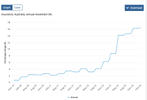- Joined
- 21 June 2009
- Posts
- 5,880
- Reactions
- 14
There is a theory out there called the SIP rule:
S = Shares
I = Interest Rates
P = Property
Shares usually lead the charge and money is poured into the market. Interest Rates begin to rise due to inflation. Market takes a dive and the money goes into fixed Interest deposits. Property starts to move. Interest rates fall. Money goes into Property.
A very simple theory that can be either a short or long wave. I used to have a graph evidencing these fluctuations which dated back to about 1912 I think? The biggest example in recent memory was that most of the money that went into the Share Market was 2 years previous to the 1987 Black Monday crash. Then with interest rates going up to 17% in 1989. House prices kept on booming right up until 1991. Short wave that time.
Anyways ..... it's just a theory.
S = Shares
I = Interest Rates
P = Property
Shares usually lead the charge and money is poured into the market. Interest Rates begin to rise due to inflation. Market takes a dive and the money goes into fixed Interest deposits. Property starts to move. Interest rates fall. Money goes into Property.
A very simple theory that can be either a short or long wave. I used to have a graph evidencing these fluctuations which dated back to about 1912 I think? The biggest example in recent memory was that most of the money that went into the Share Market was 2 years previous to the 1987 Black Monday crash. Then with interest rates going up to 17% in 1989. House prices kept on booming right up until 1991. Short wave that time.
Anyways ..... it's just a theory.






